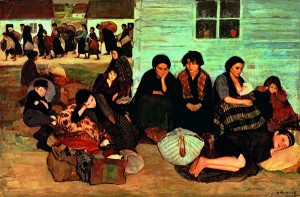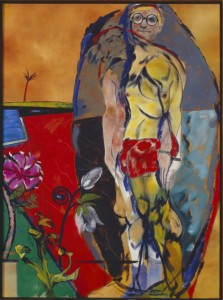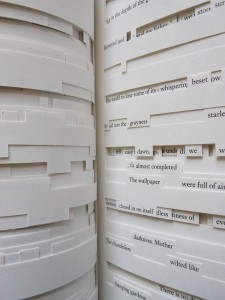50 Jewish Artist You Should Know presents the lives and work of the most important Jewish painters, sculptors, and visual artists of the past two hundred years, as selected by the author Edward van Voolen,

Maurycy Minkowski, After the Pogrom, 1910 © Prestel Verlag
curator at the Joods Historisch Museum, Amsterdam, as well as rabbi and teacher at the Abraham Geiger Kolleg, Potsdam. The book is a joy to read. The concise introduction sketches the history of Jewish art of the past three thousand years, describing major events and personalities – Bezalel, the first biblical artist, and his successors –, but avoiding the pitfall of seeking too much common ground among the artists based solely on their Jewish family backgrounds.
→ continue reading

R.B. Kitaj, The Neo Cubist, 1976-1987 © R.B. Kitaj Estate, Astrup Fearnley Collection, Oslo, Norway
On the 19th of October, just past 8 pm, I received the message “David is breaking away from his installation in Köln and will arrive at the Jewish Museum on Sunday 21st. between 11. – 11.30 am.”
Some time before, I had contacted the gallerist Peter Goulds to ask whether David Hockney might be interested in coming to Berlin to visit the R.B. Kitaj exhibition; I knew Hockney would be in Cologne to open his own exhibit “A Bigger Picture” at the Museum Ludwig. Though it seemed unlikely at first, Hockney was able to come. He brought his partner, his studio manager, and a chauffer, and appeared wearing an elegant grey double-breasted suit, a black Hawaii shirt with fantastic plants on it and a checked flat cap.
→ continue reading
Searching for a Jewish past is the topic of Jonathan Safran Foer’s Tree of Codes. His best-selling, Hollywood-adapted debut novel Everything is Illuminated (2002) already depicted a young man on a trip to the Ukraine in search of his family’s past.  His new book is also a search for Jewish roots, though this time artistic, rather than biographical.
His new book is also a search for Jewish roots, though this time artistic, rather than biographical.
Experimenting with the concept of absence, the book reproduces parts of Bruno Schulz’s Street of Crocodiles, the English translation of one of two surviving texts of a writer, whose other works were lost when the National Socialists seized his Polish hometown Drohobycz in 1941 and murdered its citizens, including Schulz, in 1942. As if to depict the loss of literature by destroying the letters in a book, Foer cut into Schulz’s pages, leaving only select words and half sentences behind, thereby reducing, already in its title, Street of Crocodiles to Tree of Codes. → continue reading


